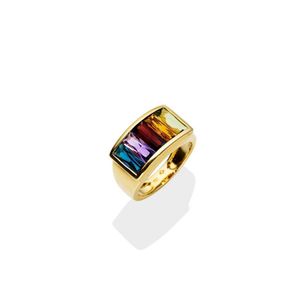1940s Retro Diamond Ring with 1.45 Carat G-SI1 Diamond
You must be a subscriber, and be logged in to view price and dealer details.
Subscribe Now to view actual auction price for this item
When you subscribe, you have the option of setting the currency in which to display prices to $Au, $US, $NZ or Stg.
- Carat - A carat (abbreviated "ct") is a unit of measurement used to describe the weight of a diamond or other gemstone, and separately is a unit of measurement used to describe the weight of precious metals such as gold,.
For gemstones, one carat is equal to 0.2 grams or 200 milligrams. The weight of a diamond is one of the Four Cs (along with cut, colour, and clarity) that are used to determine a diamond's value.
It is important to note that a diamond's weight does not necessarily correspond to its size. A diamond's cut, which affects how well it reflects light, can make a diamond of a lower weight appear larger than a diamond of a higher weight. Additionally, the carat is not the only factor to determine the value of a diamond, other factors such as clarity, colour and cut are important too.
In the gold industry, the purity of gold is measured in carats (abbreviated "ct"), with 24 karats being pure gold and lower carat numbers indicating a lower purity level. So, for example, 18 carat gold is 18/24 or 75% pure gold, and 12 carat gold is 12/24 or 50% pure gold. - Collet Setting - A collet setting in jewellery is a type of setting that is used to hold a gemstone or other decorative element securely in place. The collet is a ring of metal that surrounds the stone and holds it in place. The collet is typically made of the same metal as the rest of the piece and is often used in vintage or antique jewellery.
In a collet setting, the gemstone is placed into a small metal ring, also known as a collet. The metal ring is then bent or folded over the edges of the gemstone to hold it securely in place. The collet is then attached to the rest of the piece of jewellery, such as a ring or pendant.
One of the benefits of a collet setting is that it allows the maximum amount of light to enter the stone, which can enhance its brilliance and sparkle. It also allows the stone to be seen from the sides, which makes it a popular choice for showcasing particularly beautiful or unique stones.
The collet setting is a classic and elegant setting and it is often found in antique jewellery, particularly from the Victorian and Edwardian periods. - Bevel / Chamfer - In furniture making, a chamfered corner refers to a technique used to create a smooth, angled edge on the corner of a piece of furniture. This is typically done by cutting away a small portion of the corner at an angle, typically 45 degrees, creating a diagonal edge, rather than a sharp 90-degree angle. This technique can be used on various parts of a piece of furniture such as table legs, drawer fronts, or door frames. Chamfering can add visual interest to a piece and can help to soften the overall look of a piece of furniture. It is often used in conjunction with other techniques, such as rounding edges or using contrasting wood species to create a more elegant, sophisticated look. Chamfering is a simple way to add a touch of elegance to a piece of furniture and it is a common technique used by furniture makers.
This item has been included into following indexes:
Visually similar items

A multi-stone Rainbow ring, H. Stern, circa 1980's, channel set with amethyst, blue topaz, peridot, citrine, and garnet. 18ct yellow gold. Weight 8.17 grams. Size N ½. Original box

A citrine cocktail ring, the rectangular-shaped lemon citrine claw-set within a gold surround, the scrolling gallery to the bifurcated shoulders and hoop, citrine weighs approximately 80.00 carats, mounted in 9 carat yellow gold, ring size Q

A tourmaline and diamond ring, four claw set with an emerald cut green tourmaline of estimated weight 8.75 carats and shouldered by grain set single cut diamonds on a split band. 18ct yellow gold. Weight 16.93 grams. Size Q.

Aquamarine and diamond ring, 14ct yellow and white gold, emerald cut aquamarine flanked by four rose cut diamonds, weight approximately 4.5 grams
